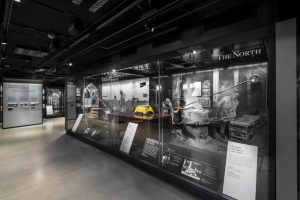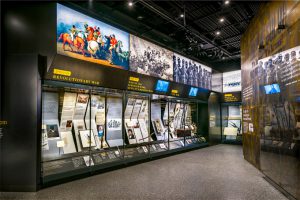
February 10, 2017 Viewing the National Museum of African American History and Culture through the Lens of Peter Vanderwarker
Guest blogger Peter Vanderwarker shares first impressions and photographs from his recent visit to the new National Museum of African American History and Culture in Washington DC. Peter is a Boston based photographer who specializes in architectural photography. He also serves on HBI’s Council of Advisors.
 In December, 2016, I was asked to take photographs of the National Museum of African American History and Culture (NMAAHC) by Goppion, the leading designer and installer of many of the exhibits at the museum.
In December, 2016, I was asked to take photographs of the National Museum of African American History and Culture (NMAAHC) by Goppion, the leading designer and installer of many of the exhibits at the museum.
When we began shooting, (very early one morning, before the museum opened) we were met by a docent who spent 12 years on the project, including a trip to South Carolina to dismantle and re-erect a slave cabin that belonged to her own ancestors. She pointed with pride to the cabin, inside the museum.
Few buildings have moved me the way this one did.I was at a lecture that David Adjaye gave at MIT last fall, where he described  his remarkably creative and thoughtful design. Adjaye brought many skills to bear on this difficult and complicated program, from overall concept to finished design.
his remarkably creative and thoughtful design. Adjaye brought many skills to bear on this difficult and complicated program, from overall concept to finished design.
As the diagonal tip of the Washington Monument points to the sky, so the precisely matching diagonals of the NMAAHC point directly down, where the journey out of slavery begins.
At NMAAHC, one of your first experiences is a slow escalator decent into a very dark, subterranean “beginning”: you literally become a slave to the building, and you spend the remainder of your visit wandering up through a ten story narrative toward freedom and light.
Like most injustices, slavery was about money: slaveowners could double or triple their incomes by planting sugarcane instead of cotton. Life expectancy for a slave working on a sugar plantation was seven years.
During the largest forced migration in human history; 12 million Africans were taken to the new world, about half to South America, the rest to the Caribbean and North America.
In a review of the building for The New York Times, art critic Holland Cotter wrote, “The extremely complex narrative, with uplift and tragedy seemingly on a fixed collision course, spreads over five floors of galleries.” Cotter added that “It’s great that the museum mixes everything together: It means you can’t just select a comfortable version of history.” He concluded, “[I] hope, actually that the museum will never be finished, or consider itself so; that its take on African-American history, which is American history, stays fluid, critical and richly confused: real, in other words.”
Moving through the building, you encounter a great variety of spaces: some tall and uplifting, many constricted and oppressive. One minute you see are displays of hope and redemption, only to be followed by one of oppression and injustice. Everywhere you look there are artifacts – from the ethereal to the material: Emancipation Proclamation is followed later by Chuck Berry’s red Cadillac.
The museum is “filled with difficult truths”, such as a statue of Thomas Jefferson, author of the words “All Men Are Created Equal” Jefferson is depicted in front of a brick wall and on every brick, the name of one of his 609 slaves, including at least six who were his own children. 
The striking statue of Jefferson that graced the exhibit was commissioned by the Smithsonian, using a Minolta 3D scanner to create a digital image of a life-size bronze statue of Jefferson which is located at Monticello. RedEye on Demand (a subsidiary of Stratasys) used a fused deposition modeling printer, which laid down tiny layers of molten plastic to slowly build the statue. The statue was “printed” in four sections, which were then put together, detailed, and painted.
This building proves that architecture can move us and enlighten us. I wish the building could grow more stories, so that the movement of all of us toward freedom can (and must) continue.





